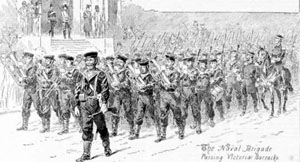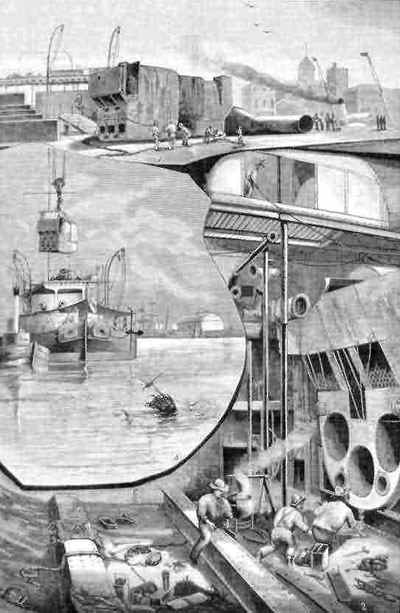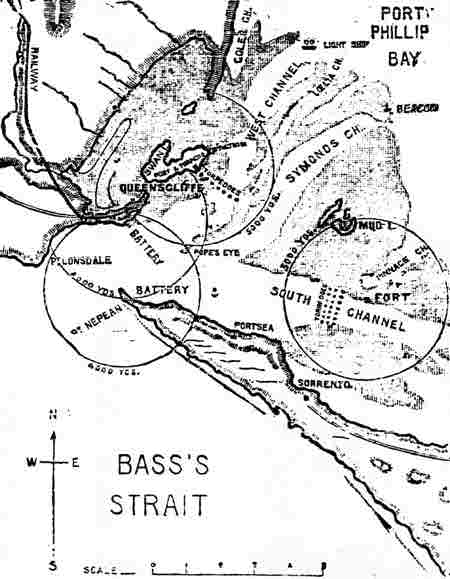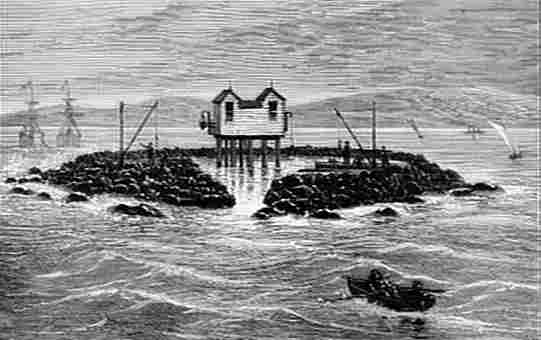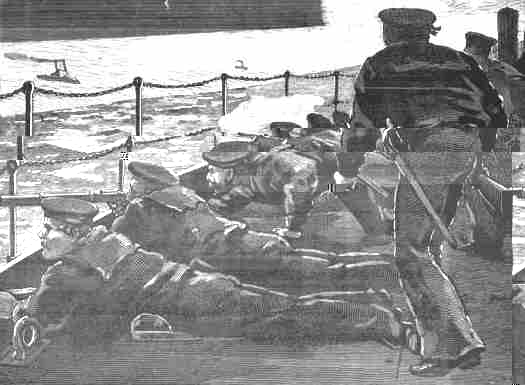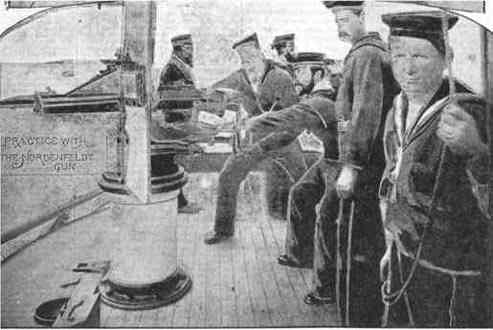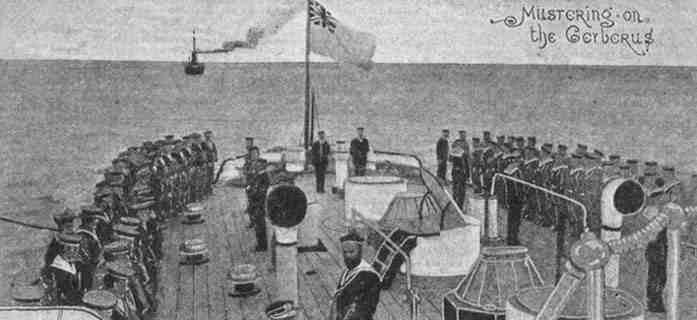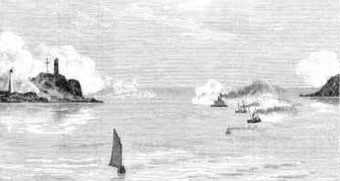The Ironclad Cerberus
The Argus August 20 1877Ever since the turret-ship Cerberus has been in these waters, it has been found that her steering gear was to a certain extent defective, as it was impossible to manoeuvre her with any rapidity in the narrow channels of Port Philip Bay. This rapidity in the narrow channels is, of course, of the greatest importance, but by the ordinary steering gear with which she was originally fitted it took eight or ten men to get her wheel over from hard-a-port to hard-a-starboard, or vice versa. Even when this was done the ship would make such a turn that it was a matter of time and difficulty to get her on a straight course again. These were all serious draw-back against her efficiency as a means of defence, and the late commander of the vessel on more than one occasion urged on the Government the desirability of having her fitted with some steam steering gear, so as to make her more manageable. This advice has always been supported by the testimony of those naval officers who have visited the port and inspected the Cerberus. It can be quite understood - even by non-nautical men - that an immense power would have to be ezerted (sic) on the rudder of such a vessel, when we state that it measures 8 ft by 12 ft, or presenting an area of 96 square feet, and giving a resistance of about 48 tons. This is the cause of the great number of men required to steer her, and as it was impossible for all to work easily and together as one man, it can be easily seen that if she was given a spoke or even half a spoke too much helm she would necessarily make a most erratic course, instead of going along in a straight line. Ultimately, in September last Sir James McCulloch gave instructions to have designs prepared for the necessary work. This was entrusted to Mr. A Wilson, the inspecting engineer to the Government, who decided upon working out an idea of his own in preference to adopting a steam steering gear in use in some of the large ironclads belonging to the Imperial navy. In the latter case, a barrel worked by steam has been adapted to the ordinary system of wheel chains working from either head of the tiller, but the noise from the continual clanking of these chains has been found to be so great that the new system has been unanimously voted a nuisance, and in some cases the old-fashioned steering gear has been reverted to. Mr. Wilson has been enabled to carry his idea into practice, and as it has now been fully tested on board the Cerberus and found to answer well some account of it may be interesting. The helmsman steers the ship from an ordinary wheel on the flying deck above the fore turret. Attached to the wheel is a screw working a series of shafts and pinnions down to the lower deck mid-ships, where it connects with and so works the reversing eccentrics of a double-cylinder engine of 12 horse power. These work on a large piston contained in an oil cylinder, from which are carried inch pipes leading aft on either side of the ship. On each side of the tiller is another cylinder in which works a ram. As the wheel is put to port the screw in the central cylinder is forced over to the starboard side, sending the oil before it, and acting upon the ram on the starboard side of the tiller , the helm is pushed to port, and at the same time the oil returns by the pipe on the port side according to the central cylinder. By reversing, the wheel on deck the opposite effect is produced according to the number of revolutions given to the wheel so is the tiller moved to port or starboard. The machinery is most ingenious, and Mr. Wilson spent a pretty good deal of time improving his design so as to render it perfect. The working drawings have been prepared, tenders called for, and ultimately that of Mr. T. Tozer was accepted, the price being about £1,600. The contract time expired in April last, but owing to many unforseen difficulties it was not until the beginning of the present, month that the whole of the machinery was in working order and ready for testing. In order, however, to ascertain whether the cylinders are perfectly tight water has been used in place of oil, in order to save the latter, and several leakages were discovered. About 10 days since Captain Mandeville took the ship about three miles down the bay for the purpose of giving the machinery a trial. Like all new engines it worked stiffly, and Mr. Wilson and Mr. Tozer, who were board, noticed several alterations necessary. It was however, admitted by all that the new method of engineering was a great improvement on the old one, and some experiments were made with the view of testing how quickly the helm could be shifted. It was then found with both engines going full speed ahead a complete circle could be made by the ship in 4m 20s. With one engine going full speed ahead and the other engine going full steam astern the circle was made in 4m 20 s. This was the same time as with the engines at full steam ahead but the diameter of the circle was much smaller. Going full steam ahead it took two men 1 m 35s to put the helm from hard-a-port to hard-a-stern at the same rate of speed it took 45 s only to put the helm from amidships to either side, while to perform the same manoeuvre with the engines going at half speed 23 s were occupied. These experiments were considered very satisfactory, as hitherto it had taken eight to ten men five minutes to put the helm to one side to another. Mr. Wilson was not, however, quite satisfied with the result, as he considered that one man should be able to alter the helm in 40 s.
 | The sailor has his left hand on the steam-steering wheel and the officer at bottom is using the telegraph to the engine room. |
The Cerberus having to leave Hobson's bay for the Heads on Monday, 13th inst. Mr. Wilson and Mr. Tozer again proceeded with her, and found that as the machinery was worked the stiffness wore off, but some of the men appeared somewhat nervous in making use of the new gear. The wheel acted much more quickly on the rudder than they had been used to that they would give her a little too much helm, causing her to make a some what uncertain course. This will however, be remedied as the men become use to steering the vessel, and the perceptible improvement was noticeable when the Cerberus was returning to her moorings on Saturday last. With some of the men she made a very straight course, while others still shifted the helm rather too much, and so caused her to "yaw" about a bit. After clearing the mouth of the South Channel some further experiments were made as to the manner in which the helm could be changed and a circle completed. It then took 19 s to put the helm from amidships to hard-a-starboard with the engine going three quarter speed ahead, and the ship described a circle in 4m 45 s. The diameter of this circle was about 150 yards. With one of the engines going ahead and the other astern at three quarter speed the ship pivoted on her centre, completing the circle in 5m 14 s. On the whole the experiments must be considered very satisfactory, and Mr. Wilson is to be congratulated on the success of his invention.
FIRING PRACTISE
As this was the first time Captain Mandeville has had the Cerberus under weigh for drill purpose at the Heads, some interest was evinced in her trip on this occasion. She left her moorings in Hobson's Bay at 9 a.m on Monday last and, proceeding down the South Channel, anchored off Queenscliff at an early hour in the evening, where she remained for the night. It was intended to proceed with shot and shell practice on Tuesday, but owing to Dr. Williams, the health officer, being in quarantine with the ship Macduff, and the other health officer having to be in readiness to clear the mail steamer on her arrival, it was impossible to obtain a doctor on board, and as it is not considered desirable to practice with the heavy guns in the absence of a medical officer, the target practice had to be foregone for the day. The men were, however, drilled steadily through the day, and Dr. M'Farlane going on board on Wednesday, the target- a small topgallant sail- was taken on shore, and erected in front of the sandstone cliff between quarantine ground and Point Nepean. In connexion (sic) with this practice Captain Mandeville inaugurated a system somewhat different to what has hitherto been the custom. The different ranges have usually been measured and buoyed, but this time that was dispensed with, and the firing all took place at about 1,800 yards, leaving those in charge of the guns to ascertain their own elevation &c. It had been intended to keep Cerberus steaming about during the firing, but as there was such a heavy sea rolling in through the Heads, it was decided to drop anchor underfoot during the practice. The weather was rougher than on any other occasion on which shot practice has been indulged in, but the shooting was exceptionally good. The fore turret was in charge of Lieutenant Heathcote and the after turret in charge of Mr. Tubbs, the gunner. Ten rounds were fired from each turret, viz, six rounds of solid shot and four rounds of shell. Another innovation was also made on this occasion, and with very good results, as it will give the men considerable instruction in gunnery practice. Usually the officer in charge of the turret has laid the gun, but this time it was decided to allow No.1 at the guns to fire two rounds each, and the No.2 one round each.
